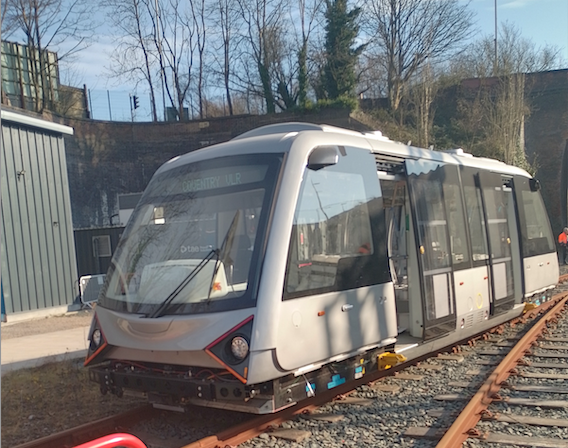
Work has commenced in Coventry city centre on the new test track for the city’s Very Light Rail (VLR) project.

Work has commenced in Coventry city centre on the new test track for the city’s Very Light Rail (VLR) project.
The 220-metre demonstration track aims to showcase how the transport system can be implemented more quickly and at a significantly lower cost compared with traditional tram networks.
Coventry City Council is leading the project, with the track being installed by Colas Rail UK under contract.
The on-road trial, set to be completed in the summer, will offer residents the opportunity to experience the new transport system first-hand, and to provide feedback. The demo track will run from Greyfriars Road through to Queen Victoria Road in the city centre, with the first track slab installed on March 17.
Nicola Small, the scheme’s director, told RAIL that the on-road tests would provide an opportunity to understand the complexities of how the VLR network would integrate with Coventry’s wider transport network.
“Obviously, now we will have traffic management to deal with, along with nine utility types to navigate on that stretch also. So, this test can prove that our track does not compromise what is already there,” she said.
A key innovation of the VLR system is its thinner track, which requires less excavation and minimises the need to divert underground pipes and cables.
This streamlined approach significantly reduces both the cost and time required for installation - the test track at the Very Light Rail Centre in Dudley took only eight days to install.
The initial plan was to install a much longer track in the city centre (up to 800 metres).
But Small told RAIL that was deemed a step too far for the scheme, and for the Department for Transport, which has helped fund the scheme.
She explained: “We worked with the DfT to ensure the funding we had secured was in the right place. We’re trying to prove that this can be built on top of utilities - therefore we agreed that it was more prudent to demonstrate this was possible and de-risking the project.
“Because the vehicle is a concept vehicle, not one for the live environment, and we’ve not had funding to build another, the DfT wanted us to prove we could keep the costs of the infrastructure down.”
Funding for the initiative comes from the City Region Sustainable Transport Settlement (CRSTS), awarded to the West Midlands Combined Authority (WMCA) by the DfT.
The initial business plan for the project had been rejected by the DfT last year, before eventually being approved.
Coventry City Council has long-term ambitions to develop a full VLR network across the city, with Cabinet Member for Jobs, Regeneration and Climate Change Jim O’Boyle describing the project as a potential “game changer” for urban transport.
“We think it will be a real game changer in terms of how people move around, especially in towns and cities,” he said.
“It will be great to see it in the street scene and for local people to actually ride on it. And of course, there is lots of interest from across the UK and further afield, so we are really looking forward to showing everyone how quickly the track can be laid - that really is the clever bit of our system.”
Once completed, the Coventry VLR test track will be showcased over a four-week period in the summer, giving the public and transport experts a first-hand look at the potential of this transformative new technology.
Login to continue reading
Or register with RAIL to keep up-to-date with the latest news, insight and opinion.

















Login to comment
Comments
No comments have been made yet.